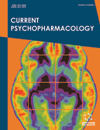- Home
- A-Z Publications
- Current Psychopharmacology
- Previous Issues
- Volume 12, Issue 1, 2024
Current Psychopharmacology - Volume 12, Issue 1, 2024
Volume 12, Issue 1, 2024
-
-
The Present Difficulties and Potential Benefits of Dopaminergic Agents in Parkinson's Disease Treatment
More LessParkinson's disease (PD) is a progressive neurological condition characterized by bradykinesia, rigidity, tremors, and impaired balance, among other motor impairments. The issue arises from dopaminergic neurons located in the spinal column of the brain. This research report examines the therapeutic potential of dopaminergic medications in the management of Parkinson's disease. The central concept of Parkinson's diseas Read More
-
-
-
Positive Psychotic Symptoms after Escitalopram Treatment in a Female Adolescent with Peroxisome Spectrum Disorder Due to PEX-6 Gene Mutation
More LessAuthors: Buket Kılıç and Dilek ÜnalIntroductionIn this case report, we present positive psychotic symptoms that developed after low-dose (5 mg/day) escitalopram treatment in a 16-year-old female adolescent with a peroxisome biogenesis disorder.Case presentationTwo weeks after starting escitalopram treatment for depression, the patient experienced vomiting attacks several times a day. About 2-3 days after the attacks began, the family stopped ad Read More
-
-
-
A Literature-Based Study of Tardive Dyskinesia- From Pathogenesis to Treatment
More LessAuthors: Banjit Kalita, Tapash Chakraborty, Shatabdi Ghose and Bhaskarjyoti KalitaTardive dyskinesia (TD) is induced by antipsychotic drugs that have dopamine-antagonising properties. It frequently causes physical and mental anguish in individuals, lowering their quality of life. Recent research on the aetiology and pathogenesis of TD indicates that genetic predisposition, treatment options, age, sex, and lifestyle factors are among the key risk factors contributing to the development of TD. Various genetic Read More
-
-
-
Psilocybin in the Management of Substance Use Disorders: A Summary of Current Evidence
More LessAuthors: Hussein El Bourji, Aziz Farhat, Zahi Hamdan, Ritvij Satodiya, Rashmi Shukla and Samer El HayekBackgroundFollowing clinical trials on psilocybin for the treatment of pain, anxiety, and depression in patients with cancer, scientific interest emerged in its use for substance use disorders.MethodsIn this review of the literature, we summarize available trials looking at the use of psilocybin in addiction.ResultsOne double-blind, randomized clinical trial looked at the effect of psilocybin on heavy drinking in adults diagnosed wit Read More
-
-
-
Rapid Metabolism of Monthly Extended-Release Buprenorphine Formulation: A Case Report
More LessAuthors: Hossameldin Tolba, Wael Foad and Samer El HayekBackgroundMedication-assisted treatment constitutes the gold standard management for patients with opioid use disorder. Many factors can alter the response to medications, including genetic variations. In this case report, we discuss the presentation of a patient maintained on subcutaneous extended-release buprenorphine formulation who repeatedly presented objective and subjective signs of opioid withdrawal when he was Read More
-
-
-
Hippocampal Serotonin and Responses to Immobilization Stress in Rats Treated with Metformin
More LessAuthors: Rushda Afroz, Tabinda Salman, Shazia Nawaz, Nazish Mustafa, Munnum Zafar and Darakhshan Jabeen HaleemBackgroundStress-related illnesses and depression are rising in modern society. Selective serotonin reuptake inhibitors as well as other antidepressants, are also not very effective and commonly exhibit partial remission, suggesting the need for novel therapeutic agents for treating anxiety and depression.ObjectiveThe present study was designed to investigate serotonergic mechanisms in the potential anxiolytic and Read More
-
-
-
Semaglutide’s Neuropharmacological Effects: From Glycemic Regulation and Weight Loss to Potential Implications in Substance Use Disorders – A Narrative Review
More LessThis narrative review delves into the potential therapeutic implications of semaglutide, a Glucagon-Like Peptide-1 (GLP-1) receptor agonist, in the context of Substance Use Disorders (SUDs). By systematically exploring databases from 2011 to 2023, and incorporating foundational works from 2004, a total of 59 articles were identified as pertinent to the topic. Utilizing the SANRA scale for assessment, the quality and relevance Read More
-
-
-
The Neuroanatomy, Etiopathogenesis, and Novel Therapeutic Targets in Depressive Disorders
More LessAuthors: Indu Arora, Kunal Khurana and Manish KumarDepression has a high prevalence and associated comorbidities. It is still unknown what the molecular basis of depression is, regardless of many theories that have been put up to explain it. Many researchers investigate that present-day therapies for depression are ineffective due to their low efficacy, delayed onset of action (typically two weeks), and adverse effects. Novel medications that operate more quickly and effectively Read More
-
-
-
The Neurochemical Anatomy of Runway Acquisition and Extinction
More LessAuthors: Robert Lalonde and Catherine StrazielleA review is presented as to the neurochemical basis of the straight runway task, usually consisting of an acquisition phase followed by an extinction phase. During the acquisition of the appetitive runway task, running speeds from the start box to the goal box progressively increase over trials and then decrease when the reward is withheld. Runway extinction is susceptible to lesions of the limbic system, including the medial frontal Read More
-
-
-
A Comprehensive Review on the Neuropharmacological Effects of Antidepressants in Various Prospects
More LessAuthors: Sandesh Varshney, Md. Aftab Alam, Awaneet Kaur and Shaweta SharmaDepression is one of the most challenging diseases for society to treat. It is a highly prevalent and disabling illness in the general population. Affective disorders are characterised by depressed mood, diminished interest and pleasure, feelings of guilt or poor self-worth, sleep or food difficulties, decreased energy, and impaired attention. This manuscript will look at depression from a behavioural analytic perspective. T Read More
-
Most Read This Month
Article
content/journals/cpsp
Journal
10
5
false
en


